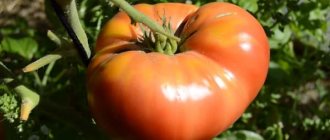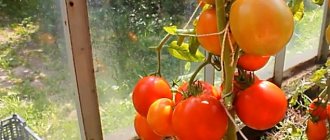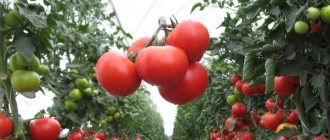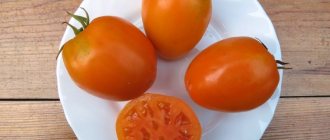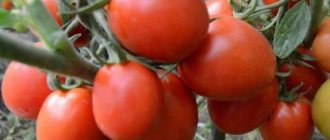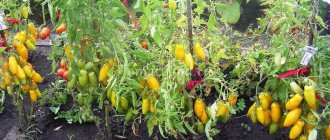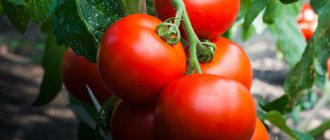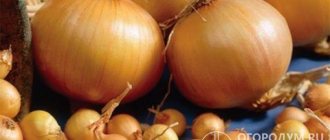| Ripening period: | 100-110 days |
| Shape, weight of fruits: | flat-round, 200-400 g |
| Bush type: | indeterminate |
| Growing regions: | all Russia |
| Productivity: | in the beds - 4.5 kg per sq.m., in the greenhouse - up to 15 kg per sq.m. |
The Malachite Box tomato is suitable for gardeners who love to experiment and test new extraordinary varieties. The tomato has an unusual, refined taste and original appearance. Despite the capriciousness in care, the variety deserves attention due to its cold resistance, high yield, and exceptional taste of fresh fruits. This is one of the most productive tomatoes of Siberian selection.
Description and characteristics of the variety
Mid-season tomatoes Malachite Box from agro were bred in 2006 by breeders from Novosibirsk. They are distinguished by their cold resistance and resistance to abnormal weather conditions, like all Siberian varieties.
The crop is suitable for growing in garden beds, but exhibits better varietal qualities and significantly higher yields when grown in greenhouses.
The Malachite Box bush, up to 1.5 m high, is densely covered with dark green foliage. The first brush is formed above the tenth sheet. The variety has almost no sterile flowers; the tassels are completely tied.
At the stage of technical ripeness, tomatoes acquire a “malachite” color: sinuous yellow streaks are located on a bright green background. Ripe tomatoes acquire a yellowish color (see photo).
Ripe fruits have the thinnest skin through which the pulp shines through. The taste of the Malachite Box is sweet, with the aroma of ripe melon and juicy kiwi. The pulp is emerald green with a honey tint, sugary, tender, and contains a small amount of seeds.
Overripe tomatoes on the bush do not crack, but acquire a brown color and become watery.
Malachite box tomatoes picked at the stage of milk ripeness should be stored separately from red vegetables so as not to miss the ripening time.
Reproduction methods
The Malachite Box tomato (reviews indicate the possibility of growing it in summer cottages) is mainly propagated by seeds. Since this variety is not a hybrid, tomatoes grown from self-harvested seed will inherit all the qualities of their “parents” and will be just as “malachite,” sweet and aromatic.
However, harvesting seeds will require patience and experience. The ideal candidate for the honorary role of “continuator of the family” is a specimen that grew on the lower fruiting branch of an absolutely healthy, strong plant, has reached the optimal degree of maturity and does not have any external defects or damage to the skin.
In overripe fruits, seeds may sprout during further processing, since they lack a protective shell that protects them from premature germination. Determining the moment of collection is one of the main difficulties that the breeder will have to face.
The picked fruit is cut lengthwise so that the cut provides access to all seed chambers. Next, the seeds, along with the pulp surrounding them, are removed, after which they must be processed. The purpose of the treatment is to remove residual pulp, which would otherwise create an airtight film on the surface of the seeds when drying and significantly reduce their germination.
Necessary:
- place the seeds along with the pulp surrounding them in a glass jar;
- add a small amount of water;
- close with a leak-proof lid;
- leave in a warm place for 1-2 days to ferment.
When the contents of the jar lighten, the seeds sink to the bottom, and turbidity collects in the upper part, the contents of the jar must be drained, and the seeds should be placed in a sieve and rinsed thoroughly under running water to remove any remaining pulp.
The washed seeds are thoroughly dried on a flat surface for 5-7 days, and then collected in fabric bags, paper bags or other breathable containers. Until spring, the seed is stored in a cool, dry, dark place.
A less commonly used method of propagating tomatoes is cuttings. It will help out in case of low seed germination and, accordingly, insufficient number of seedlings, as well as in case of too high growth due to early planting or prolonged cold weather.
You need to do the following:
- Remove the buds (if they have already appeared on overgrown plants) and cut off the top of the plant.
- Remove the lower leaves from the cut part,
- Treat the stem with a biostimulant (for example, Kornevin).
- Place in a container with water.
The resulting “bouquets” should stand for about 10 days, during which time roots will appear on the stems, after which the cuttings can be planted in pots and cared for like ordinary seedlings. This method makes it possible not only to double the number of seedlings, but also to restrain their growth if the time for planting in the ground has not come.
If growth inhibition is not required, then the cutting method can still be used, using stepsons as planting material, which, after being removed from the mother plant, must be processed in a similar way.
Sowing dates and features of agricultural technology
You need to plant seeds for seedlings depending on your region of residence, but not earlier than the second ten days of March. Malachite Box seedlings tend to stretch.
Features of tomato cultivation:
- The bushes are spreading; 2 plants are planted per 1 sq.m.
- The seedlings are immediately tied to a support or trellis.
- The bush is formed into 1-2 stems.
- Carefully monitor the growth of stepchildren, remove them in a timely manner, preventing the shoots from becoming dense.
- The tomato is demanding on watering and fertilizing and does not tolerate drying out of the top layer of soil. Water the plant regularly, 1-2 times a week depending on the weather, abundantly.
- Mulching between rows facilitates weed control and serves as protection against fungal pathogens.
- The crop's brushes are fragile, with pronounced joints, and easily break under the weight of the fruit. Timely gartering of each hand helps to cope with the problem.
- In mid-August, the top growth point of the box is pinched. This technique allows the main crop to ripen.
- The plant, if agricultural practices are followed, bears fruit until late autumn and tolerates low night temperatures well.
It is better to pick tomatoes of this variety unripe than to allow them to become overripe. When harvesting is delayed, there is a significant loss of taste and presentation.
Transplanting to a garden bed
2 months after sowing the seeds for seedlings, the tomatoes are transferred to a permanent place. As a rule, this time falls at the end of May or beginning of June. For greenhouse cultivation, these dates may be earlier.
This process consists of the following steps:
- the soil for the garden bed is prepared 2-3 weeks before transplanting the seedlings - the soil is dug up, fertilized with complex fertilizers and watered with warm water with the addition of potassium permanganate;
- dig holes - their dimensions must correspond to the root system of the seedling along with the lump of earth in which it is located;
- the recesses are sterilized with boiling water with the addition of potassium permanganate;
- the seedlings are carefully transferred into the hole, deepening it a little more than before - this will allow the formation of additional roots;
- the voids in the hole are filled with soil, slightly compacted in the root zone and the first watering is carried out;
- per 1 m² there are no more than 2 bushes, which are planted in a checkerboard pattern;
- After planting, a reliable support is placed near the plants, to which the stems will later be tied.
It is better to transplant in the evening, then by morning the seedlings will have time to rise.
Disease resistance of the variety
The cultivar is resistant to the main fungal and viral diseases of nightshades. The main task of the gardener is to protect plants from late blight in order to prolong fruiting as much as possible.
Measures to prevent late blight in the greenhouse:
- thorough autumn cleaning of plant residues;
- soil treatment in the off-season with the Baikal preparation;
- spraying bushes in June with 1% Bordeaux mixture or other fungicide;
- mulching between rows;
- regular ventilation after watering to reduce air humidity and condensation on plants;
- dusting plants with sifted wood ash;
- trimming the lower leaves to the level of the first fruiting cluster.
We must not forget about the fight against parasitic insects that are carriers of diseases. Whiteflies spread black sooty fungus, while aphids cause viral incurable pathologies.
Tomato malachite box
I love different varieties, and I also grow the Malachite Box tomato. When ripe it is greenish-yellow, in the first year I couldn’t figure out when I could pick it, so I ate several unripe ones. This is the main difficulty - they become sweet at a certain time, but you have to guess it, the appearance doesn’t really tell. I focus on maximum yellowness in the color, but green is always present in them. In the Kaluga region, the climate suited him even in open ground. The harvest is moderate, the fruits are large, I collect several pieces from the bush, eat them fresh and make dressings.
Ripe tomatoes look like a huge gooseberry. The skin is yellow-green, with obvious stripes. The shape of the fruit is mostly irregular and flattened. Tomatoes of different sizes ripen on one bush (from 200 grams on the upper branches to 900 grams on the lower ones). The size directly depends on the planting conditions (greenhouse or unprotected soil) and the quality of care. The yield is similar: up to 5 kg per square meter. m. in ordinary beds and up to 15 kg under cover. Plants quickly respond to properly selected fertilizers. I try to use balanced ready-made ingredients and organic matter. The pulp is very tender and juicy; care must be taken when transporting the harvested crop. The sugar content is high, the sourness is not felt at all. This is not the best option for canning, since the pulp is greatly deformed and the skin is prone to cracking. But the fruits are good fresh (in salads you need to be careful with dressings so as not to overpower the delicate taste with a light fruity tint) and are suitable for any type of processing (juices, pastes, purees). Preventive treatments against insect attacks, fungal and viral diseases are necessary. Immunity to common diseases is average.
Advantages and disadvantages
Positive qualities of the Malachite box:
- beautiful malachite color and pleasant taste of the fruit;
- sugary pulp with a delicate consistency, thin skin;
- hypoallergenic fruits, suitable for children's and dietary nutrition;
- plant resistance to cold weather and temperature changes;
- 100% tying of brushes;
- extended fruiting;
- high yield when grown in protected soil;
- good seed germination;
- strong immunity to diseases.
Disadvantages of tomato:
- capricious in care;
- not very suitable for canning because the skin is too thin;
- do not tolerate transportation well;
- are stored for a short time;
- the difficulty of determining the ripeness of a tomato when growing for the first time.
The description and characteristics of the variety speak of the many positive qualities of the tomato. To get a decent harvest, you will have to put in a lot of effort.
Specifics of cultivation
It is advisable to grow the Malachite Box variety in a greenhouse, since it is easier to care for tall bushes, and the yield is larger.
Preparing soil and containers
The Malachite Box tomato grows well in fertile, light soils. A simple solution for growing seedlings is to buy a nutrient mixture at a specialty store. You can prepare the soil yourself - mix equal parts of humus, peat and turf soil. There is no need to specially fertilize the soil, since the seeds do not particularly require fertilizing to germinate. It is better to fertilize the soil after germination.
The planting material is planted in a wide box, which is pre-disinfected (doused with boiling water or a solution of potassium permanganate). The strengthened seedlings are later planted in separate containers.
Seed preparation
Self-collected planting material is first sorted. For this, tomato grains are placed in a malachite box in a slightly salted solution. For sowing, grains that have settled to the bottom are collected.
Preparation for germination is carried out in several stages:
- to disinfect grains, place them in a pale solution of potassium permanganate for 20-30 minutes, then remove them and wash them under running water;
- to increase crop productivity, planting material is soaked in special preparations that stimulate growth: “Epin”, “Immunocytophyte”;
- The grains for germination are wrapped in wet gauze or cloth and placed in a warm place. It is necessary to constantly maintain the moisture of the fabric.
Comparison with similar varieties
According to the characteristics and description of the variety, the Malachite Box tomato is similar to the following cultivars:
- Giant emerald is a mid-season variety for greenhouses and open ground with a growing season of 105-110 days. Bushes 0.8-1 m stocky with wrinkled potato leaves. Tomatoes are round in shape, green with a yellow blush, weighing 200-400 g. 4-5 kg of crop is harvested from the plant. Has high immunity to diseases.
- Cherokee Green Golden is a variety bred by US breeders. The tall 1.8 m indent needs shelter. Flat-round, slightly ribbed fruits 300-400 g in color, old gold, have green flesh with a sweet taste. The yield is good - 7-8 kg per plant. The variety is resistant to phytopathologies.
- Tomato Everett's Rusted Heart is a cultivar of American selection, an indeterminate tomato 1.8 m high for greenhouses. Ripens 110-120 days after planting the seeds. The heart-shaped, fleshy fruits weigh 250-350 g and are bronze-green in color. The pulp is juicy, sweet, green when cut with pink streaks. Tomatoes have average resistance to nightshade diseases.
Varieties similar in description, mainly of foreign selection, have poor adaptation to the weather factors of Russian regions. The seeds of these tomatoes are difficult to buy. Malachite Box is a cultivar bred in Siberia, with a set of qualities for cultivation in our harsh conditions.
Caring for plants in the ground
Agricultural technology for growing tomatoes Malachite box includes standard techniques: watering, weeding, fertilizing. Experienced summer residents note that when the fruiting phase begins, watering does not stop, since the period of fruit set and ripening is extended.
The best choice is organic compounds. The first time fertilizing (mullein infusion) is applied two weeks after transplanting the seedlings. During the flowering period, mixtures containing superphosphate and potassium fertilizers are used. The last time the combined fertilizer is added is when the first fruits grow to the size of a walnut.
Malachite box tomato bushes are formed into one or two stems. Stepchildren are regularly removed. The foliage is torn off to the first flower cluster. It is advisable to mulch the beds to prevent the growth of weeds and drying out of the soil.
